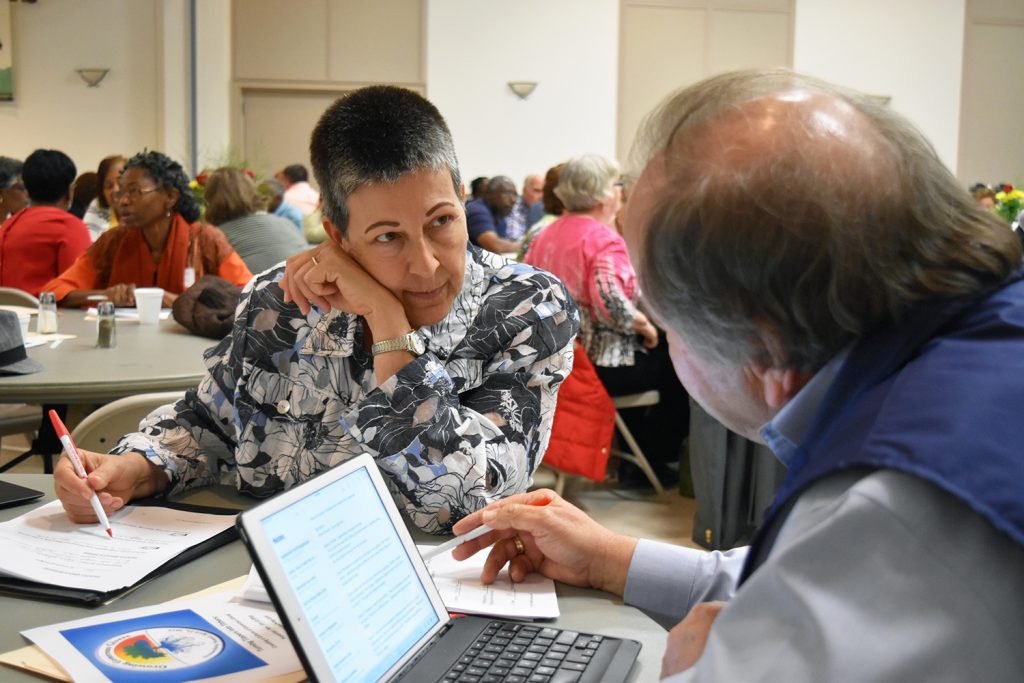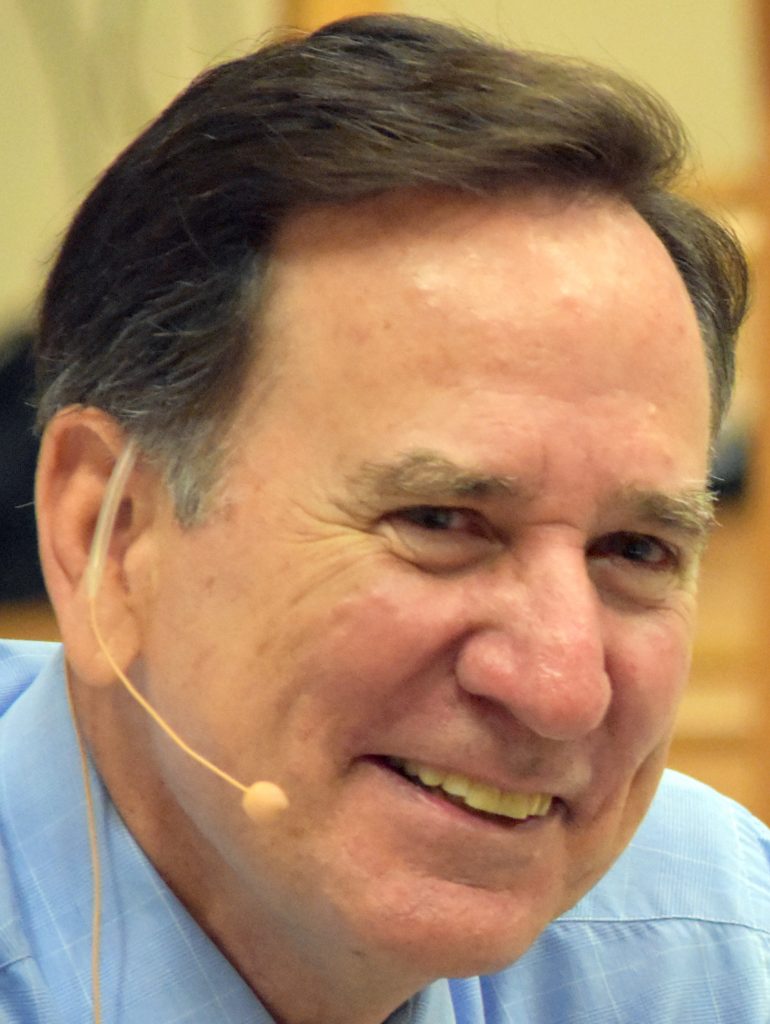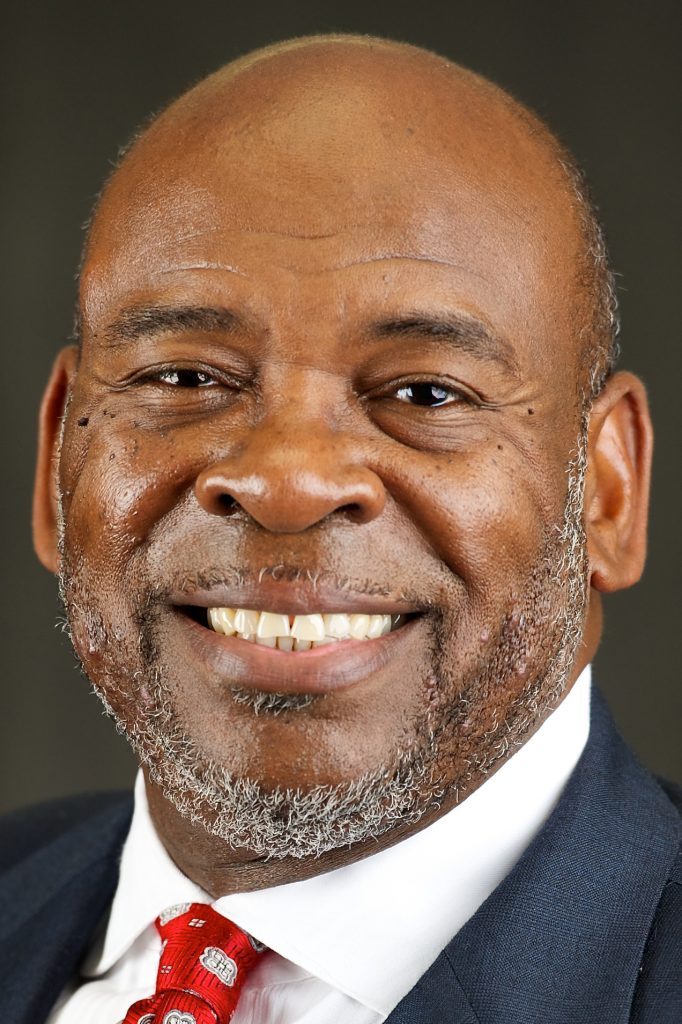
Churches today find themselves in a challenging competition for the charitable dollar – especially among their younger members – and must change their approach to stewardship.
More than 120 pastors and other local church leaders gathered April 21 at Bethany United Methodist Church in Summerville for the 2018 Stewardship Summit of the South Carolina Conference of the United Methodist Church.

“People used to give to your church out of loyalty and obligation, but now you have to work to earn the right for them to invest in your church,” said the Rev. Jim Griffith, founder of Griffith Coaching, who led the “Growing Generous Givers” event.
“It doesn’t come with birth. It doesn’t come with membership.”
Rev. Griffith, who has coached church leaders on stewardship and other matters for more than 20 years, introduced the group to strategies addressing how to develop a culture of generous giving and how to conduct an effective stewardship campaign.
Bishop L. Jonathan Holston urged those in attendance to “be sure we are growing generous givers all the way around.

“It’s not just about giving the dollar, it’s about growing the generosity,” he said. “It does not matter how big or small your church is, whether you’re a station church or a three-point charge. Growing generosity is not just for the benefit of the churches, it’s for the benefit of our communities, as well.
“When you get home, don’t think about the impossibilities, think of the possibilities. For scripture tells us that all things are possible for them who love the Lord.”
Throughout Rev. Griffith’s presentation – titled “Turning Tippers Into Tithers: Creating a Culture of Generous Giving” – he cited two publications, which he called must-reads for local church finance leaders and pastors:
- “Not Your Parents’ Offering Plate,” a book by the Rev. Clif Christopher, which posits that “people don’t give to church because we don’t offer them a compelling vision of the good their giving will achieve.”
- “Stewardship and Giving: How to Increase the Financial Support of Your Congregation,” a workbook by the Rev. Kevin Martin, which maintains that the fundamental mistake made by most congregations is “treating all potential donors the same.”
Rev. Griffith – citing Rev. Christopher’s book and a 2015 study by the Indiana University Lilly Family School of Philanthropy’s Philanthropy Panel Study – startled many with a handful of statistics about church giving:
- In 1985, 53 percent of all charitable givers were members of a church. By 2006, only 32.8 percent were.
- In 1995, there were 600,000 non-profit organizations competing for charitable dollars. By 2011, that number had tripled, to 1.8 million.
- United Methodists give 2.23 percent of their income to charity, which included their church giving.
- One-third of United Methodists do not give any money to charity, and nearly two-thirds don’t give money to their own church.
“Those last numbers actually are hopeful,” Rev. Griffith said. “It shows there’s room for improvement for churches. If 25 of 25 United Methodists gave money to their church and your budget was still in the red every year, you would be up the creek without a canoe, much less a paddle.”
‘Principles of giving’
Rev. Griffith pointed out that more than 2,000 Bible verses address money and possessions.
“Jesus talked more about what you do with your money in this life than he ever talked about the afterlife,” he said, turning to Luke 12:34 as an example. “‘For where your treasure is, there your heart will be also.’ (NIV)
“If God doesn’t have your money, God doesn’t have your attention. If God doesn’t have your attention, God doesn’t have your affection.”
Rev. Griffith reviewed 12 “principles of giving” from which all stewardship efforts should spring:
- It takes money to do ministry.
- To do more ministry, it takes more money.
- The pastor must practice tithing (with some exceptions).
- The pastor plays the primary role in raising the level of financial giving in a congregation.
- The pastor must know how much the members are giving.
- The lower a person’s income, the higher percentage of their income they tend to give.
- Money follows vision – always.
- When it comes to money, churches tend to ask for too little.
- Send givers monthly receipts via e-statements.
- Introduce e-tithing as an option for giving.
- When a new or renewed financial gift is made, send an immediate thank you note.
- Transparency builds trust. Share the church’s financial information openly with members.
The idea of a pastor’s knowing what individuals give to the church prompted spirited debate among both clergy and lay leaders in attendance – but Rev. Griffith made the case for it.
“The primary reason for the pastor to know how much members are giving is so he or she can provide the appropriate pastoral care,” he said. “Pastors who don’t know try to assume, they try to predict, they turn into prophets and seers.”
When Rev. Griffith was a pastor, he asked the church treasurer to alert him when a family’s giving increased or decreased. If giving increased unsolicited, he said, he would write a personal thank you note. If a church member’s giving decreased, he would make an appointment to talk with him or her about it.
“I would ask, ‘As your pastor, has something occurred that I may need to be aware of?’” Rev. Griffith said. Many times, “they’re going to start to tear up or get very serious, and then they share with you a secret in their family. A secret kept is a burden. A secret shared is an opportunity to help that family through a crisis.
“This is what a pastor is created for – to help a person or family face their burden, and walking them out the other side.”
Rev. Griffith also walked through specific ways churches can develop generous givers – it’s a year-round process, not just during the stewardship season – as well as a game plan for how to conduct a stewardship campaign.
“The biggest stewardship mistake churches make is treating all potential givers the same,” he said. “A person giving $20 a year is motivated very differently than someone giving $20,000.
“The truth is – in life, as in ministry – we treat different people differently. People are in different places in their lives.”
‘Concrete steps’
Armed with specific, step-by-step guidance, most of those who attended the summit expressed optimism afterward about the potential for shaking up the culture of giving once they returned home to their local churches.
The Rev. Susan Maddox, pastor of St. Paul United Methodist Church in Saluda, said she and Ralph Riley, the chairperson of St. Paul’s finance committee, were able to map out a logical timeline for conducting their annual stewardship campaign, including when to preach a sermon series about financial stewardship – not during the campaign itself.
“The summit taught us concrete steps to address the reality that people in the congregation are at very different places when it comes to financial commitments to the church,” Rev. Maddox said. “We learned how to have both healthy and different conversations with regular tithers and with those who are occasionally giving money to the church.”
Rev. Maddox said she appreciated the reaffirmation – from Griffith and district superintendents in attendance – of instructions in Paragraph 340.2.c(2)(c) of the UMC Book of Discipline that pastors need to know what the members of their congregation are giving financially to the ministry of the church.
“That allows the pastor to provide appropriate pastoral care,” she said, “to lead those with a gift of giving into better stewardship of their gift, and avoid nominating uncommitted board members to key committees of the church.
“Implementing this step will be a new direction for St. Paul, who – like many other churches – has operated under the ‘misunderstanding’ that giving records are not to be shared with the pastor.”
Paula Stover, chairperson of the Stewardship Committee at Trinity United Methodist Church in Sumter, said she was motivated to put into practice as quickly as possible what she learned at the summit.
“My takeaway is that we need to focus on developing a multi-generational, well-informed, dynamic approach to creating a culture of generosity at Trinity,” said Stover, who also serves as vice chairperson of the church’s Finance Committee. “Our culture must be founded on a generous spirit of giving that is motivated by a ‘higher principle,’ rather than an economic or purely financial need.
“This would include sharing regularly how funds are used to support areas of service that are relevant to the community and the world we are in, making it easier and more convenient to give, and reaching out to those who may not regularly attend but are on the rolls and may want to participate in giving.”
